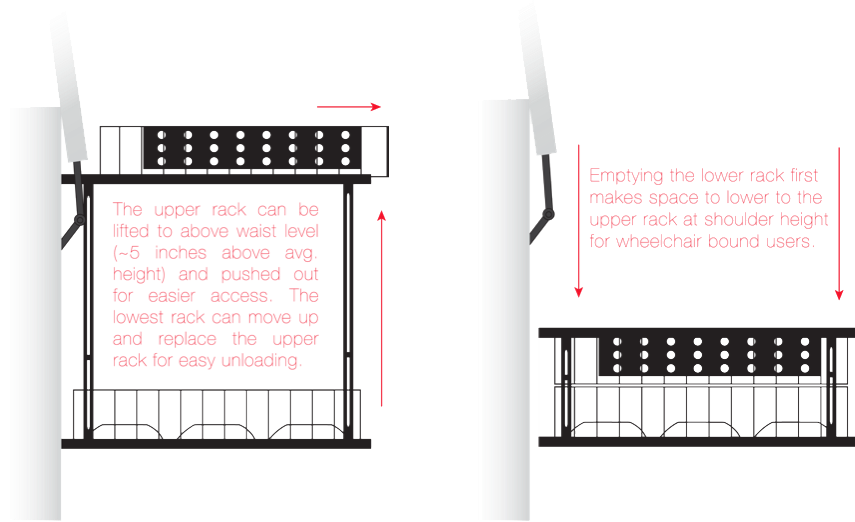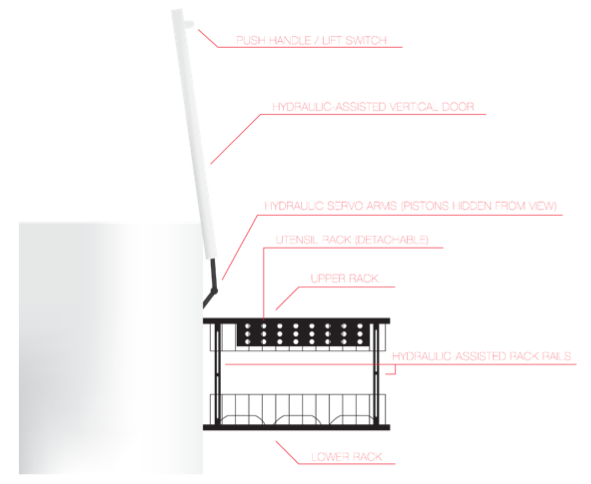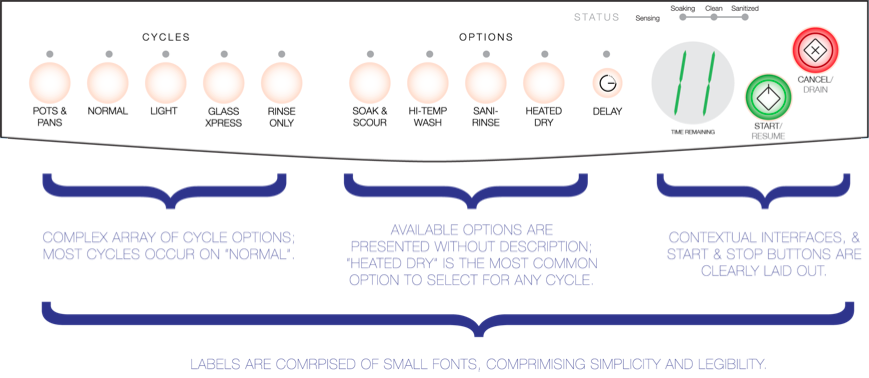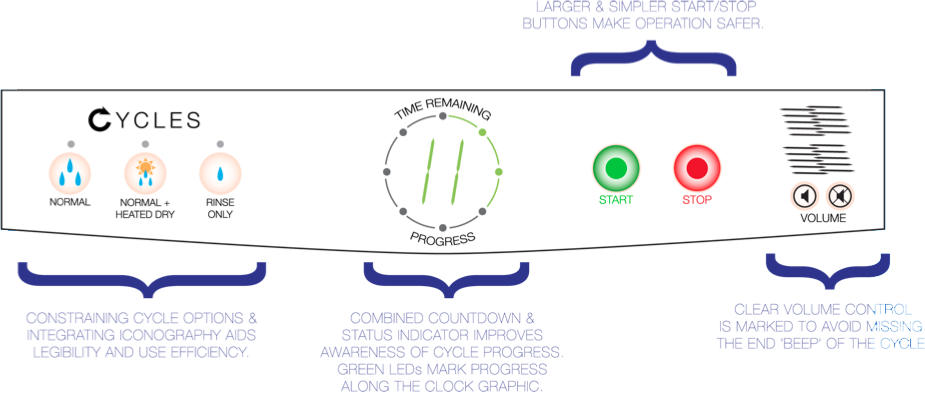Redesigning the Household Dishwasher
Ricky Lau
CCT434H5 Design Thinking II
Sheridan College's President Creative Challenge 2012—13
30 November 2012
Section One: Proposal
The proposed idea is to redesign the dishwasher, specifically the door and how it opens, the position of the racks, a grey water appropriation system, and a simpler control interface. Older adults, particularly those living in smaller residences, experience severe back pain and ultimately early fatigue as a result of the dishwasher’s silhouette. Wheelchair bound users are forced to be static when loading the appliance due to the volume occupied by the door when open. Bipedal users are limited to how they can load the trays also due to the volume occupancy of the door parallel to the floor. As a redesign, the new dishwasher door lifts vertically — perpendicular the floor it was parallel to. In order to ensure the weight of the door does not add stress to users with limited capabilities, the door will be assisted by hydraulics.
A dishwasher’s racks are always positioned below waist level beneath a user’s kitchen counter top. As a result, older users must endure chronic back pain to completely load their dishwasher. Our remedy to this is a vertical hydraulic system similar to the one that lifts the door, designed to lift the racks to above waist level as well as lower than average to assist wheelchair bound users.
Grey water — waste water originating from sinks, dishwashers, and washing machine, is generated and immediately sent to municipal treatment facilities to be cleaned. This quality of water is full of food particles, particulate dirt, and cleaning detergents, all of which do not present immediate biological threats like black water — toilet and shower water waste, and is simply wasted. The grey water produced by the washing machine can be reintegrated into the hydraulic systems rather than being sent immediately to treatment facilities.
Finally, mistaken commands are often made due to small type detailing ambiguous and often inappropriate icons that represent the dishwasher’s operation. Continuous malfunction can lead to extensive water waste or premature deterioration of dishes and mechanics by over saturation of detergents. The user interface will be redesigned for ergonomics and legibility.
Target Audience
Our target audience for the dishwasher redux is an amalgamate of older adults aged 55 and older, as well as wheelchair bound users or users with limited mobility. The users either live independently in a home, group home (ie. retirement home) or a extended care facility (ie. nursing home) who are capable to producing their own meals and managing the treatment of their dish ware.
Section Two: Comprehensive Description
The idea is to redesign the conventional dishwasher, thereby improving the experience of cleaning dishes and managing independence. The conventional dishwasher possesses a number of inherent flaws, even after the most recent two decades of significant improvements to efficiency. As described in the project proposal, the dishwasher is problematic when considering the volume of the open door, tray height, and grey water disposal.
In early November, Professor Elizabeth Littlejohn — the instructor of our team’s CCT434 class on Design Thinking, organized a group brainstorm with members of SERC (Sheridan Elderly Research Centre). Four representatives of the senior community in the Greater Toronto Area answered questions regarding their environment and living experiences as well as regaled personal opinions or problems with their environment. One representative answered a question pertaining to at-home living conditions; more specifically, offered complaints of back pain and fatigue after using the dishwasher. “A Portrait of Seniors in Canada” conducted by the Canadian Federal Government1 reveals the prominence of various degrees of arthritis and fatigue disorders in Canadians who are 55 or older. These disorders are worsened through the repetitive and uncomfortable task of filling a dishwasher. The user is forced to extensively reach or crouch when loading or unloading the dishwasher. Taking into consideration that many senior users, as well as countless younger ones, undergo painful and disabling disorders such as arthritis, the need to redesign the dishwasher becomes apparent. In many cases, fatigue and pain experienced by the user is caused by bad design, and can be avoided through intelligent redesign. Our team’s redux will improve the user’s comfort when handling the dishwasher in all aspects.
Aspect One: Hydraulic 90° Door
The foremost issue with the dishwasher is the considerable floor space that is occupied by the open door that lies parallel to the floor. Many members of the target audience live in small homes or apartments, and even shared space. When a dishwasher is open in a small kitchen, more than 30% of previously open floor space (excluding all volume occupied by standard kitchen furnishings) is suddenly occupied. This instant consumption of volume reduced walkable area for users and increases energy expenditure for users with limited mobility. More importantly, wheelchair bound users are rendered virtually static with no transit space around the door. So, the inherent flaw is the position of the open dishwasher door.
Our remedy is a redesign of simultaneously how the door opens and where the door opens. In figure 1b, the dishwasher door is illustrated moving vertically along a track with the assistance of hydraulic pistons powered by recycled grey water (see ‘aspect three: grey water’). A user can either lift the door manually and use the hydraulics as force assistance (powered by an auxiliary line containing grey water) or s/he can press a button to engage a hydraulic piston powered by the main hydro line. Now that the door is perpendicular to the floors as opposed to parallel, users regardless of mobility restrictions has significantly more unoccupied floor space to navigate.
Aspect Two: Adjustable Racks
A dishwasher’s secondary flaw is the constant position of dish racks. By design, the dishwasher is intended to occupy as little space in the kitchen as possible. This is most easily accomplished by integrating the appliance with the space around it, which is why it is almost always found below a countertop. This does present an inherent issue: below waist level height. Users with arthritis and chronic fatigue disorders must endure extreme pain or discomfort when reaching down to load the washer’s trays. In order to minimize the user’s fatigue and pain during use, the redesigned dishwasher reduces the user’s need to excessively reach or crouch when loading and unloading utensils. This can be accomplished through the implementation of extendable metal arms that can bring the dishwasher’s trays proximate to the user’s position and height.
Made apparent in figure 2, the arms of the racks can be positioned to raise or lower the racks. Pain and discomfort is remedied by eliminating the most apparent cause. Wheelchair bound users can simply lower the racks to their arm’s height to load the washer as opposed to endangering themselves with extensive reaching and balancing.
Aspect Three: Grey Water
Waste grey water is the run-off of kitchen sinks, dishwashers, and laundry machines. This differs from Black Water generated from toilets, bathroom sinks, and showers/bathes, based on biologically hazardous particulate matter that originates from open sores, bodily waste, and naturally infectious diseases (such as any sexually transmitted infection). The particulate matter in grey water is comprised mainly of food and dirt particles, and detergents rendering it safe for reuse by appropriate means. Obviously not safe to drink, grey water is sent immediately to the municipal water treatment facility to be filtered into drinking water.
The hydraulic system incorporated with the door mechanism in the dishwasher redux, will have an integrated line system with both grey water and clean water for power. Grey and clean water replaces toxic chemicals used as hydraulic fluid. A split line to grey water and clean water will provide a ratio of clean water with the particle-dense grey water in order to prevent blockage in the hydraulic tubing.
Aspect Four: User Interface
User interfaces on household appliances have a reputation for being convoluted. Constant misuse through illegibility leads to premature deterioration of the appliance and dishes by an over saturation of high pressure water spray and harsh detergents. The four representatives from SERC expressed unanimously the difficulty associated to operating a dishwasher exclusively due to a badly designed interface. The redesigned interface will be clear by utilizing large legible font as well as an integrated e-ink screen that displays cycle details. Operational commands will be simple and programmed to perform complex cycles as a factory default (see figures 3 and 4). The device aims to maintain communication with the user throughout operations.
The device offers visual, auditory, and tactile cues as feedback so that it can successfully communicate despite the possibility of visual or auditory impairments in the user. Visual and auditory cues involve the common flashes, text in displays, and beeps. Tactile cue involves the tactile writing system of braille. Braille is readily present on the device’s buttons. Moreover, the device implements “interactive braille.” Interactive braille involves miniature pockets that are inflated and deflated by stored water. The sets of dots are raised and lowered according to the status of the operation, alongside updating text, flashes, and beeps. The redesign’s interface is accentuated and prominent to ease control.
Next, the redesign implements biomimicry of structural coloration2 to dye the interface in bold colours, as well as the appliance itself. As opposed to relying on potentially toxic pigments, the redesign uses structural coloration to produce colour for the dishwasher’s labels and the display.
Business & Financial Considerations
The adaptation of the redesign will benefit businesses, government agencies, and community organizations. Businesses already understand the profitability of the dishwasher considering that dishwashing services are required virtually wherever food is prepared or served. Whether a person eats in or out, dishwashing services are most likely required. Businesses will appreciate the redesign because on top of the dishwasher’s wide acceptance, people naturally prefer and pursue healthier lifestyles in addition to increasing environment awareness.
The redesign also correlates with the interests of government agencies, as it minimizes the instances of health issues and injuries of the user. This, in turn, helps relieve the pressure on the healthcare system. The redesign’s reuse of water reduces pressure on the utility system. The aforementioned positives of the redesign will likewise be deemed attractive in the perspective of community organizations. Briefly, the redesign considers and addresses to all three pillars of the Triple Bottom Line (TBL): people, planet, and profit.
Theoretically, the redesign’s potential buyers and users are identical to those of the conventional dishwasher. However, the redesign better appeals to buyers and users, especially those afflicted with health issues, the older population, or services pertaining to them (e.g. retirement homes).
Implementation Strategies
In order for the proposal to become implemented and sustained, the whole system theory must be repeatedly considered. The product will surely benefit from consultation with multi-disciplinary experts, as well as companies that design and manufacture dishwashers, such as General Electric Company.
Team Member Roles
The team members include two students of the course CCT434 Design Thinking II, Matthew Azzopardi and Ricky Lau. Azzopardi recruited Peter Broadhurst as the team’s mentor. Lau registered the team for the President’s Creative Challenge. Both team members collaborated throughout the different stages of the redesign, including brainstorm, redesign, refinement, and ultimately the completion of the application.
Involvement in the Community
The team connected with [retired aeronautical engineer] Peter Broadhurst. Broadhurst supported the team by providing valuable mechanical knowledge and advice regarding proposed design. Moreover, he also helped the team by sharing his daily life as a senior citizen, as well as his experiences with the conventional dishwasher.
Bibliography

Figure 1a. An isometric representation of the dishwasher redux illustrates the lack of variation in external design; this eliminates unnecessary mold manufacturingand logistics. Transparency present only to display internal layout.

Figure 1b. An isometric representation of the hyraulic component in the dishwasher redux door.

Figure 2a. A profile image illustrating the possible rack positions.

Figure 2b. An exploded profile view of the dishwasher redux.

Figure 3. A graphic representation of a current generation “simple” user interface (brand and model undisclosed).

Figure 4. A graphic representation of the dishwasher redux user interface.